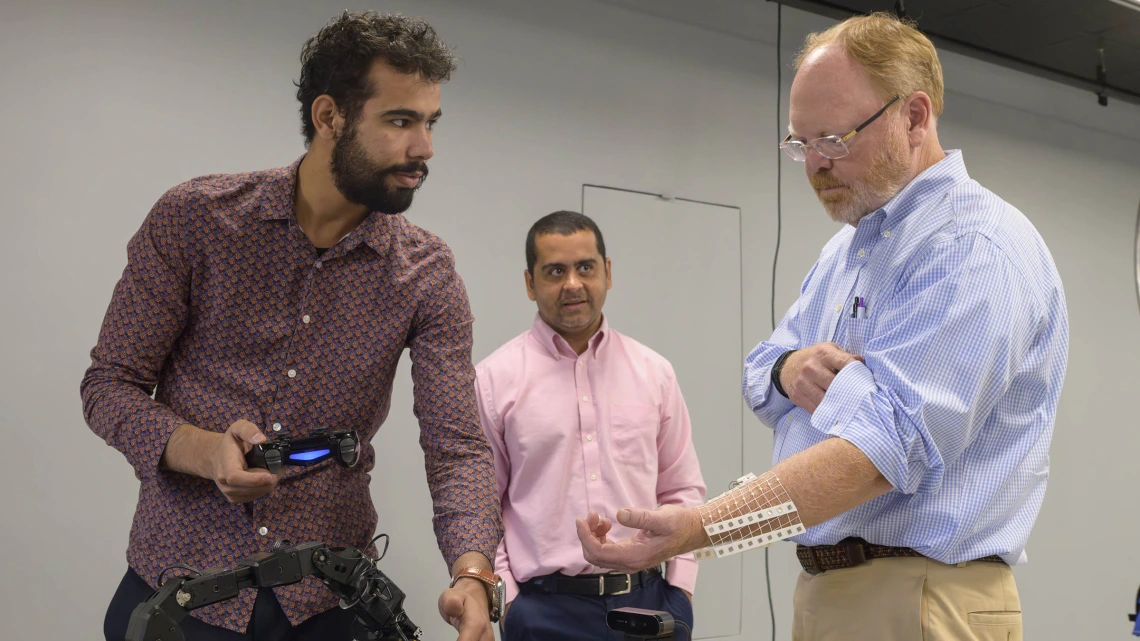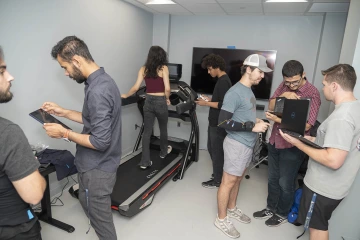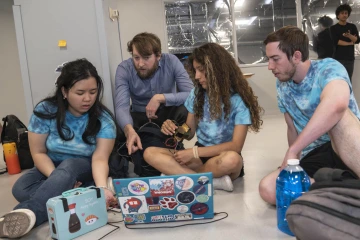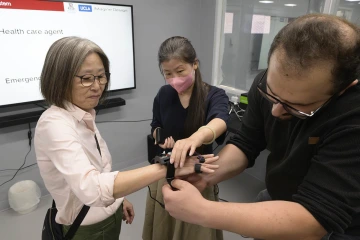Collaboration, creativity is key to SensorLab’s success
Since opening in spring 2022, the UArizona Health Sciences SensorLab has supported research projects with over 250 unique sensors.

(From left) Qusai Almustafa, a SensorLab intern, and Gustavo Almeida, PhD, SensorLab manager and former UArizona Health Sciences Data Science Fellow, demonstrate how wearable sensors enable Wes Gullett, director of operations for the WearTech Center in Phoenix, operate a robotic arm in the UArizona Health Sciences SensorLab during a tour sponsored by the Greater Phoenix Economic Council.
Researchers from across the University of Arizona have found a valuable resource and collaborative partner for an increasingly wide variety of research in the University of Arizona Health Sciences SensorLab.
A UArizona Health Sciences strategic initiative, the SensorLab opened in the spring of 2022 to help create new frontiers for better health. The lab serves as a hub to bring students, faculty, industry and community partners together to encourage creativity and innovation in research and education by providing access to sensor technology and expertise.

Students from a biomedical engineering class test wearable device prototypes they created to assist people with neurodegenerative diseases against gold standard sensors available in the SensorLab. The medical device design class is taught by Philipp Gutruf, PhD, an assistant professor of Biomedical Engineering and a member of the BIO5 Institute.
“The SensorLab gives us access to a vast array of multipurpose devices that we can quickly use to validate our results, formulate hypothesis and kickstart our research ideas,” said Shravan Guruprasad Aras, PhD, assistant director of sensor analytics and smart devices platforms in the UArizona Health Sciences Center for Biomedical Informatics and Biostatistics. “Without these resources, we would have to spend considerable time and money buying devices for the study. The SensorLab team has been very helpful towards all our project and research needs and they have been excellent collaborators.”
Jennifer Barton, PhD, a professor of biomedical engineering who leads the SensorLab and is director of the BIO5 Institute, said it has been gratifying to see the interest in the SensorLab from both faculty and students.

Jennifer Barton, PhD
The lab is managed by Almeida, a former UArizona Health Sciences Data Science Fellow who said these first 18 months have taught him a lot about how to best support researchers from around the university.
“Each investigator that comes to us has different needs, and we are tailoring the way to respond to their needs according to what is demanded by them,” Almeida said. “This learning experience has supported our model of providing different ways to interact with the research community, ranging from providing equipment to work alongside some projects to providing sensor support comprising software and data analysis to hardware selection and troubleshooting.”
An example of such customization by the SensorLab team was the development of a custom algorithm and data analysis procedure to analyze large-scale physiological data produced from a Smartshirt (wearable sensor) while collecting data from emergency physicians in high-stress situations during COVID-19. “We developed a new and custom sensor data analysis pipeline that included data extraction, conversion, quality evaluation filtering, analysis and visualization,” Almeida said. “Interestingly, this data analysis approach is being directly applied to a new SensorLab Seed Grant proposal in which the same sensor will be used, but in a different context, greatly improving the analysis possibilities and optimizing the process.”

Philipp Gutruf (center) helps students from his biomedical engineering class analyze the data they collected while testing their device in the SensorLab.
The SensorLab’s ever-growing inventory of equipment consists of over 250 unique items — video, audio, VR technology, wearable sensors, computers, tablets and software — that are available to be loaned or used in the lab. That number will continue to grow as the lab purchases equipment to meet a benchmark of critical sensors. It will also expand as further seed grants are awarded for new projects. Those grants go toward the purchase of sensors or software for a specific research project, and the equipment goes into the SensorLab inventory after the project is completed. Researchers can also submit a form suggesting that the lab purchase specific equipment. Those requests are evaluated, and if deemed beneficial for potential research projects, the equipment can be bought using the lab’s equipment budget.
Saving time and money
One of the recurring themes when talking with researchers who are utilizing the SensorLab is how it enables them to determine which types of sensors can work best for their research needs without having to invest time and money into equipment that may not ultimately work for them.

Students in Philipp Gutruf’s biomedical engineering class test a therapeutic device they created to help patients with neurodegenerative disease manage symptoms that effect their ability to move their hands. The device provides therapeutic capabilities and helps to diagnose disease progression.
Wung has two active projects using the SensorLab. One, funded by Innovations in Healthy Aging, uses multiple wearable sensors provided by the lab to monitor older adults’ daily vital signs, activities, sleep and stress to construct an individualized baseline for the older adults. In the second project, Wung’s team is using SensorLab sensors to monitor heart rate variabilities, an accelerometer to measure one’s activities, as well as a respiratory sensor to measure breathing, explained Wung. “We are integrating these sensor data to identify stress-related heart rate variability changes and to prompt specific breathing strategies to lower stress,” Wung said.
Aras is similarly enthusiastic about the benefits of working with the SensorLab. “During the exploration phase, where we just want to try out various sensors to use as data collection instruments, the SensorLab’s vast selection of devices is a great asset since it’s impractical for us to buy one of each device to explore for a research study.”
Benefits of collaboration
One of the great advantages to having a centralized facility and support team running the SensorLab is that with each new collaboration on a research project comes new knowledge about how to use sensors and data retrieval in novel applications. Almeida said that he and his team have realized that everyone collaborating with the lab has varied experience and perspectives that bring value to a project.

(From left) Kathleen Lee, senior vice president of regional initiatives for the Greater Phoenix Economic Council, is fitted with a wearable device by Xuejing Wang, PhD, and Mehrdad Pourjam, to demonstrate a research project funded by the SensorLab seed grants. Both Wang and Pourjam are members of the Hazeli Research Group in the department of Aerospace and Mechanical Engineering.
Researchers using the lab agree.
“The SensorLab team has been very helpful toward all our project and research needs,” said Aras. “They have been excellent collaborators with us and helped us implement parts of our sensor data ingestion pipelines. We look forward to continuing our work with them.”
“The staff is incredibly helpful in meeting our research needs, not only to faculty but also to helping graduate students we are mentoring,” said Wung.
Much of the SensorLab’s success and growth has come from the exploration of new sensors and technology before their applications are fully understood.
“Much of our research comes from trying, risk-taking, and embarking on new technologies and even equipment before we fully understand them,” said Almeida.
“I’d like to keep building our user base and start welcoming more collaborations with people outside the university, including investigators from other universities, industry developers and community participants in studies,” Barton said. “Dr. Almeida has done an amazing job getting the SensorLab off the ground and being useful for so many research projects. Whether you are developing novel sensors or think that existing ones could help add value to your research project, he and the small but mighty team are ready to help!”

